#funerary sculpture of a horse
Text
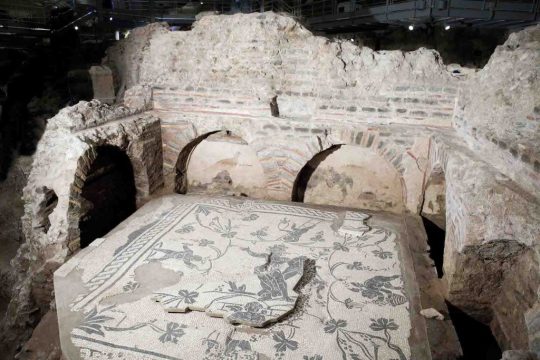
Vatican Museums Opens Ancient Roman Necropolis to the Public
The site was previously only accessible to scholars and specialists.
The Vatican Museums has newly opened to the public an ancient necropolis stocked with carved marble sarcophagi and bone-filled open graves of everyday ancient Romans.
The word necropolis comes from the Greek expression for “city of the dead.” These “cities” grew up alongside roads outside the urban center due to laws forbidding cremation and burial of the dead inside city limits. Funerary practices and rites are preserved especially clearly in the necropolis that extends along the Via Triumphalis (a Roman road now known as the Via Trionfale), with burial sites accompanied by eye-popping Roman frescoes and mosaics.
Previously, the necropolis was accessible only to certain groups of scholars and specialists. It is now open to the public via the new Saint Rose Gate entrance, inaugurated with the exhibition “Life and Death in the Rome of the Caesars.”
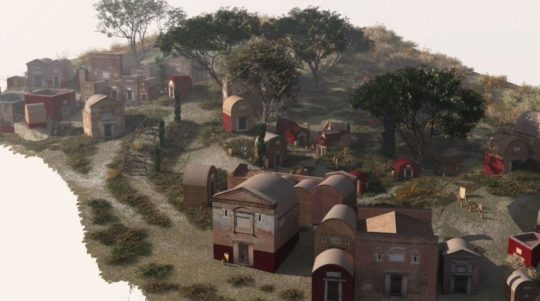
How extensive is the archaeological area?
It extends nearly 11,000 square feet. The size of the necropolis is not as extensive as some other Roman burial sites, but its importance lies in its proximity to one of the most significant religious sites in Christianity.
What is known about particular people who are buried there?
According to archaeologists, no less than the tomb of St. Peter himself is located in the Vatican Necropolis.
But in general, “Here, we have represented the lower middle class of Rome’s population,” said Leonardo Di Blasi, an archaeologist with the Vatican Museums, in a video on Euro News. “They are essentially slaves, freedmen, artisans of the city of Rome.” Some were the property of the emperor, and are indicated to have been the “servant of Nero.”
One of them was a man named Alcimus, who was the set director for the downtown Theater of Pompeii, the most important theater of the period. Another was a horse trainer who worked at the chariot races.
One young boy is interred there, according to the Catholic News Service, marked by a sculpture of a boy’s head accompanied by an inscription reading “Vixit Anni IIII Menses IIII Dies X,” Latin for “He lived four years, four months, and 10 days.”
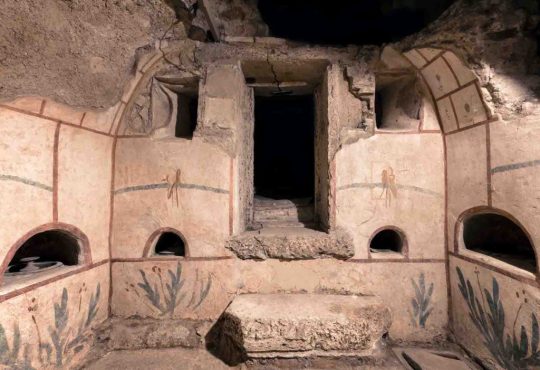
How did this ancient burial ground come to light?
The Vatican burial grounds were first explored in the 1940s at the request of then Pope Pius X, who wanted to be buried near the grave of Peter the Apostle. The dig revealed numerous mausoleums and tombs.
The newest part of the burial ground was revealed through an infrastructure project in 2003, as the Vatican excavated for a new multilevel employee parking garage.
What happened when the Vatican discovered these newest burial grounds?
The department of the Vatican that was overseeing construction of the parking garage, intent on meeting its deadline, was accused of trying to conceal the find, Giandomenico Spinola, an archaeologist and deputy artistic-scientific director of the museums, told the Catholic News Service. It was only when journalists publicized the discovery that he and his colleagues were invited in to advise.
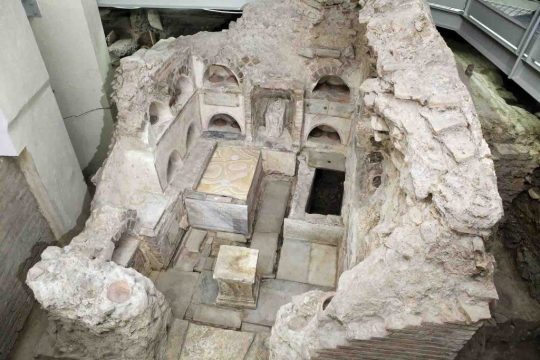

When were the bodies there buried? How have the tombs been so well preserved?
Bodies were interred in this burial ground between the first century B.C.E and the fourth century C.E., and organic remains have vanished. A number of the graves, including their tombs and decorations, including frescoes, mosaic floors, and marble-carved inscriptions, were fortuitously preserved by a series of mudslides in the area.
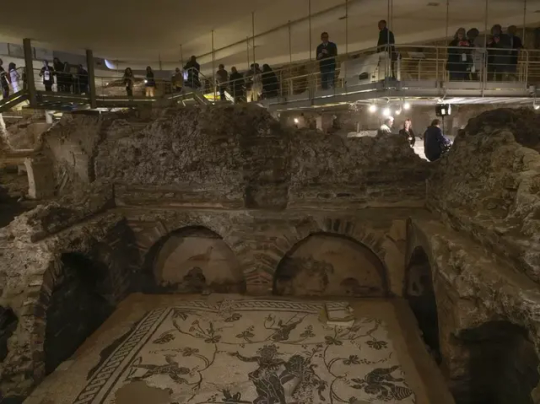
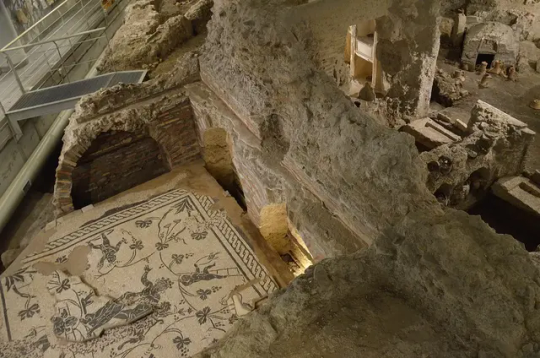
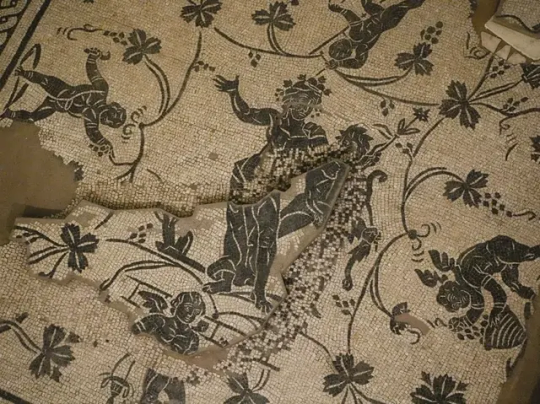
#Vatican Museums Opens Ancient Roman Necropolis to the Public#The Vatican Museums#Ancient Roman 'City for the Dead'#Via Triumphalis necropolis#Life and Death in the Rome of the Caesars#ancient graves#ancient tombs#ancient necropolis#ancient artifacts#archeology#archeolgst#history#history news#ancient history#ancient culture#ancient civilizations#ancient rome#roman history#roman empire#roman art
264 notes
·
View notes
Text

MWW Artwork of the Day (1/13/24)
Qin Dynasty (Chinese, 221–206 BCE)
Soldier of the "Terracotta Army" (c. 210 BCE)
Ceramic sculpture
Who says you can't take it with you? if you're a Chinese Emperor you can even take your army with you -- sort of. The Terracotta Army or the "Terracotta Warriors and Horses", is a collection of terracotta sculptures depicting the armies of Qin Shi Huang, the first Emperor of China. It is a form of funerary art buried with the emperor in 210–209 BCE and whose purpose was to protect the emperor in his afterlife. This here is a life-size rendition of one of the warriors.
11 notes
·
View notes
Text
Hinterlands: Tyrdda Bright-Axe Path

Tyrdda Bright-Axe was a legendary Alamarri chieftain attributed with founding the Avvar.
I personally thought that following the stanza [complete saga here] would point me out to Avvar sculptures. But I had strange results.
Also, the way these stanzas are written are quite difficult for me to understand, so any misinterpretation or mistake pointed out would be appreciated.
Updated December 2022
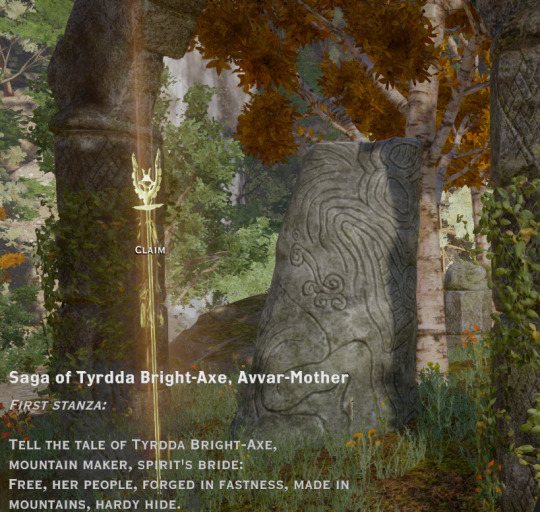
First stanza is given by the wolf/horse statue. It makes sense because it’s an Avvar/Alamarri statue, in the open, surrounded by avvar/alamarri arcs. The first stanza mostly says that Tyrdda was gifted in diplomacy and wisdom, and had a spirit as a lover who had the shape of an elf and it was considered The Lady of the Skies. Here is where the presence of elves among the Avvar shows.
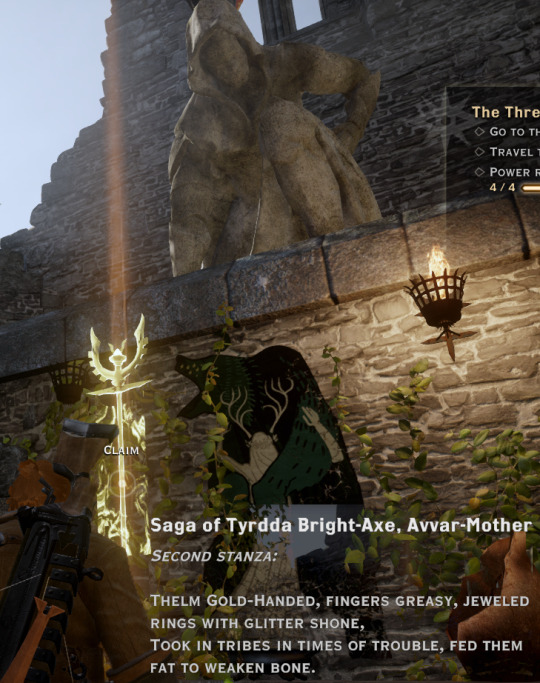

Second stanza… things begin to look very strange. It’s triggered inside the Calenhad’s foothold, which is a recent construction, but we can assume that Tyrdda lived in the zone [close to the Calenhad Lake, after all]. Inside, there are many Ferelden paintings on the walls, and in a corner, we find the statue that triggers this stanza: the one usually considered elven, representing Dirthamen [Or Falon’Din, read the post Exalted Plains: Northern Ramparts and Citadelle du Corbeau for more details on this statue]
This stanza speaks about one of Tyrdda’s suitors: Thelm Gold-Handed, who apparently was a strong warrior; took weak clans, fed them and turned them into his army giving them weapons and armour. Apparently a demon [whispers in his dreams] encouraged him to reach a Golden City in the north. Even though it sounds similar to the Chant of Light, we also have Arlathan which was considered a “golden city in the north” by humans [We know in the Shattered Library that it was blue and more like a sky], so this stanza may mean Arlathan as well as the Golden City for all what we know.
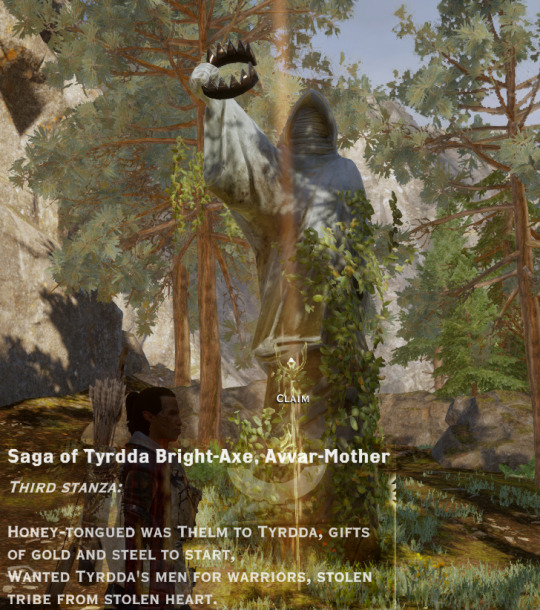

The third one is the mysterious Faceless figure holding a crown. It’s this same statue which allows you to rise an undead, which tomb shows Elvhen funerary lids. Is this statue Elven related? If the executors are an odd elvhen faction, and if that statue is an executor [simply because we can’t see their skin or face], maybe this situation could make a little more sense. So far, to me, makes no sense at all.
Updated December 2022: I finally managed to understand and justify the statue Faceless figure holding a crown. It's andrastian and represents the Maker. The stained glass of Andraste's life represents him as a figure without face with a crown that looks very similar to this one. As The Maker, it makes a lot of more sense for it to appear in the places it does.
The third stanza basically says that Thelm wanted to marry Tyrdda to have her men as part of his army to reach the Golden City. She was tempted, since her tribe was starving due to the hard winter and the promises of food in the Golden city made her hesitate. She looked for the counsel of her elven lover, who saw the lies in Thelm. So that Tyrdda rejected him.
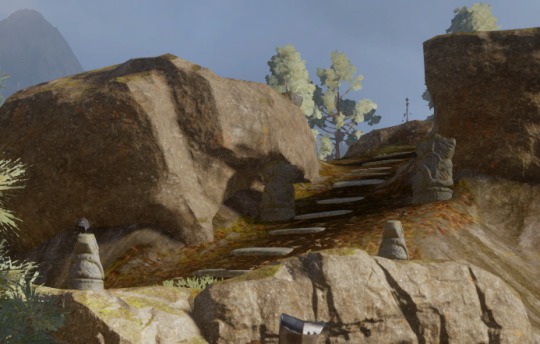

The fourth one is nicely marked on a hill through a path guided by the little guys of long arms and moustache [that I’m fond to consider the avvar representation of Dwarves with long limbs]. On its top, we find this eroded statue that looks like a dragon head [See the post Hinterlands: Statues, paintings, and structures found in the open]
The fourth stanza explains how Thelm did not take the rejection of Tyrdda well and fought her, wearing armour. He damaged her leg, but she killed him by burning him inside his armour, using the staff of her elven lover.
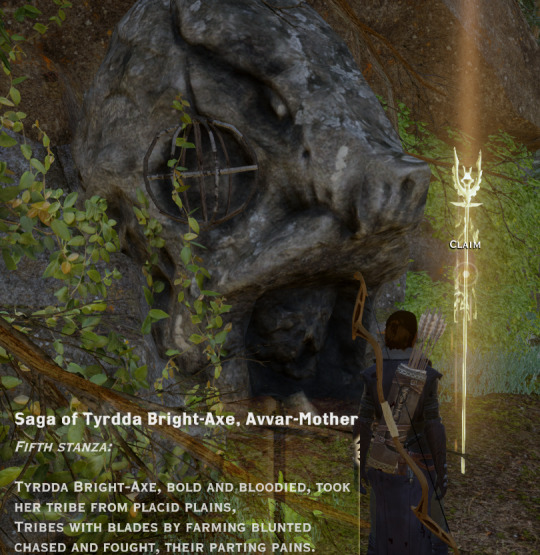
The fifth staza is triggered by a screaming head, one of the Keepers of Fear.
The stanza tells that Tyrdda took her tribe and left the Calenhad lake heading to the Frostback Mountains. They took shelter in a cave where a dragon was found. She asked for help to her elven lover, shouting her: "You I chose above a crown!" and the dragon was struck from the skies, saving the tribe.

The sixth stanza confirms my supposition that this statue is the avvar representation of a dwarf: it tells how after the battle, strong and shaped by the struggles, she went deeper into the cave reaching the Deep Roads, meeting the dwarves for the first time: Hendir’s men. The encounter was tense, ready to attack each other, until Tyrdda’s lover whispered her information to understand these men. She explained her that they were honourable, so Tyrdda chose to trade with them instead of making war.

The seventh stanza is found in the central massive sculpture of crossroads [Hinterlands] that must represent Tyrdda herself. It explains that after spending a night with her elven lover, the elf left her, whispering in her dreams that she needed to have a child in order to continue with the tribe. She had a baby with the dwarf prince Hendir, following the advice of her lover, who told her that one of her line, Morrighan'nan, “will shine in strength”.

The last stanza is found in this place where we can see one of these small sculptures with a dove that I thought were Andrastian. It says that once Tyrdda saw her tribe stable, strong and safe with the alliance with the dwarves, she put her child as chieftain of the tribe and left to the skies to reunite with her elven lover in the afterlife [sky burial].
[Index page of Dragon Age Lore ]
#avvar#avvar design#tyrdda bright-axe#Monolith with swirls#Humanoid Dirthamen/Falon'Din#Faceless figure holding a crown#Dwarf with long limbs#Eroded dragon skull#Keepers of Fear
21 notes
·
View notes
Text

Terracotta equestrian figure from Bura-Asinda-Sikka, in the modern-day Republic of Niger, c. 3rd – 10th century AD.
This relatively large terracotta sculpture (62 × 52 × 20 cm) of a horse and rider belongs to one of the more enigmatic archaeological cultures of West Africa, situated on the lower Niger River valley of Niger and Burkina Faso. The ancient necropolis of Bura-Asinda-Sikka was first discovered in the Tillabéry Region, about 120 km northwest of Niamey in 1975, and first excavated in 1983. Hundreds of anthropomorphic terracotta funerary urns containing human remains were found at the site. Some of these urns were surmounted by sculptures of standing figures, mounted horsemen, or human heads, all highly stylized. Very little is known about this iron working culture from a region that would eventually give rise to the powerful Songhai Empire.
19 notes
·
View notes
Text
Ancient Chinese relics
Four-ram Zun
Early bronzes of the late Shang Dynasty. It belongs to ritual utensils and sacrificial items.
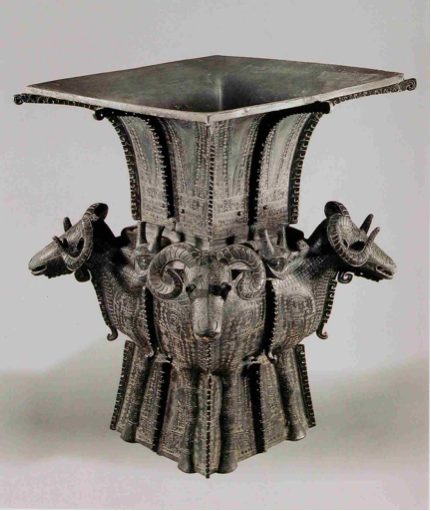
Terracotta
Terracotta Army (Terracotta Army; Terra-cotta Figures; Soldier and Horse figures) is a category of ancient tomb sculpture. In ancient times, human martyrdom was practiced, and the slave was an accessory of the slave owner during his lifetime, and the slave had to be buried for the slave owner after the death of the slave owner, which was a funeral object. Terracotta warriors and horses are funerary objects made in the shape of terracotta horses (chariots, war horses, soldiers).

Yuan blue and white Guiguzi descending the mountain picture jar
The blue and white pattern is painted with imported cobalt material, which is divided into four layers, the first layer of the neck is decorated with water ripples, the second layer of the shoulder is decorated with entwined branch peonies, the third layer of the abdomen is the theme of "Guiguzi descending the mountain", and the lower part of the fourth layer is the deformed lotus petal pattern painted with Chenbao, commonly known as "eight big yards". The theme picture depicts the story of Sun Bin's master Guiguzi, who agreed to go down the mountain to rescue Sun Bin and Dugu Chen, the famous generals of Qi who were trapped by Yan State, at the repeated request of Su Dai, the envoy of Qi State.

Sanxingdui Ruins Official
It has a history of 3,000 to 5,000 years, and is the ancient city, ancient country and ancient Shu cultural site with the largest range, longest duration and richest cultural connotation found in southwest China so far. The best-preserved eastern, western, and southern city walls and the inner city walls of Moon Bay. The Sanxingdui site is known as one of the greatest archaeological discoveries of mankind in the 20th century, showing that the Yangtze River Basin, like the Yellow River Basin, belongs to the mother of Chinese civilization and is known as the "source of Yangtze River civilization".

The history of the excavation of the Sanxingdui Ruins Official
The astonishing discovery of the Sanxingdui site began with a pit of jade tools that local farmer Yan Daocheng accidentally discovered in 1929 when he was driving water and digging a ditch. In the spring of 1931, the British missionary V· H· When Donnithorne heard the news, he approached the local garrison to help publicize the protection and investigation, and handed over the collected jade artifacts to the West China University Museum run by the Americans for safekeeping. According to V· H· In the spring of 1934, David C. Graham, director of the West China University Museum, and assistant Lin Mingjun formed an archaeological team, presided over by Luo Yucang, the magistrate of Guanghan County, to conduct a ten-day excavation near the discovery of jade artifacts in the Yan family. The excavation was rich in harvests, and according to these materials, V·H· Donnithorne compiled the "Hanzhou Excavation Briefing". Since the first excavation of the Sanxingdui site in 1934, the excavation has been stagnant for a long time.




In 1929, the discovery of the Sanxingdui Ruins Official began with a pit of jade tools that local farmer Yan Daocheng accidentally found when he was digging gou.
From 1980 to 1981, the remains of Neolithic houses were cleaned up, and tens of thousands of specimens were unearthed, from which the "Sanxingdui Ruins Official" got its name.
In 1982 and 1984, archaeologists carried out two excavations in the southwest and Xiquankan of the Sanxingdui Ruins Official, respectively, and found the remains of the latest Sanxingdui site.
In July 1986, two major sacrificial pits in Sanxingdui were unearthed one after another, and a large number of unique and exquisite cultural relics attracted the attention of academic circles at home and abroad to the ancient Shu civilization in southwest China.
In 1988, the State Council separately organized a review of the Sanxingdui Ruins Official, and it was announced as a national key cultural relics protection unit that year.
From 1989 to 1995, Sanxingdui workstation has carried out test excavation of the "mound" outside Sanxingdui for 6 times, clarified the nature of its artificially built city wall, and delineated the scope of the ancient city of Sanxingdui with an area of 3.6 square kilometers.
In 1992, the foundation stone of Sanxingdui Museum was laid.
In May 1993, Sanxingdui Ruins Official relics were exhibited at the Olympic Museum in Lausanne, Switzerland. Although there is only one piece, it has caused a lot of repercussions in Switzerland and Europe. After that, European countries frequently invited Sanxingdui treasures to be exhibited in Europe.
In 1997, Sanxingdui Museum was completed and opened, and its basic exhibition won the top ten exhibitions of national museums that year.
In 2002, the Sanxingdui unearthed cultural relics bronze sacred tree and Yubianzhang were included in the "Catalogue of the First Batch of Cultural Relics Prohibited from Going Abroad (Territory) Exhibition" issued by the State Administration of Cultural Heritage.
From 2012 to 2015, Sanxingdui archaeology discovered the foundation site of large houses in Qingguanshan and important cultural relics of many sections of the city wall, and the ancient city wall of Sanxingdui was enclosed.
In April 2019, Sichuan issued the "Implementation Opinions on Strengthening the Reform of the Protection and Utilization of Cultural Relics", and the joint application of Sanxingdui and Jinsha sites as a World Heritage Site became a highlight.
On March 20, 2021, more than 500 important cultural relics have been unearthed in the six "sacrificial pits" newly discovered in the archaeological work of the Sanxingdui site, of which ivory was found in three pits. On March 21, the Sanxingdui archaeological "new" continued, and a ivory weighing more than 100 catties in the No. 4 pit was completely extracted; On April 12, a complete round-mouth square statue was successfully extracted from the No. 3 pit of Sanxingdui site, which is also the first complete round-mouth square statue unearthed by scientific archaeological excavation.
On May 28, 2021, the Sichuan Provincial Institute of Cultural Relics and Archaeology announced that the excavation of 6 newly discovered "sacrificial pits" in Sanxingdui has yielded a lot of harvests. In addition, the Sanxingdui site will be declared a world cultural heritage in conjunction with the Jinsha site, and the Sanxingdui National Heritage Park will be accelerated.
1 note
·
View note
Photo

~ Funerary Sculpture of a Horse.
Place of origin: China, Sichuan Province
Culture: Eastern Han dynasty
Date: A.D. 25-220
Medium: Molded earthenware with modeled and carved decoration.
#ancient#ancient art#ancient sculpture#funerary sculpture of a horse#china#eastern han dynasty#a.d. 25#a.d. 220
232 notes
·
View notes
Video
Emperor Qinshihuang's Mausoleum Site Museum, China
#兵马俑#Terracotta#Army#兵馬俑#soldier#warrior#horses#cavalry#funerary#earthen#clay#ceramic#sculptures#Emperor#Qinshihuang#秦始皇#Qin#Shi#Huang#Mausoleum#Site#Museum#UNESCO#World#Heritage#Xi'an#西安#中國#China#中国
50 notes
·
View notes
Photo
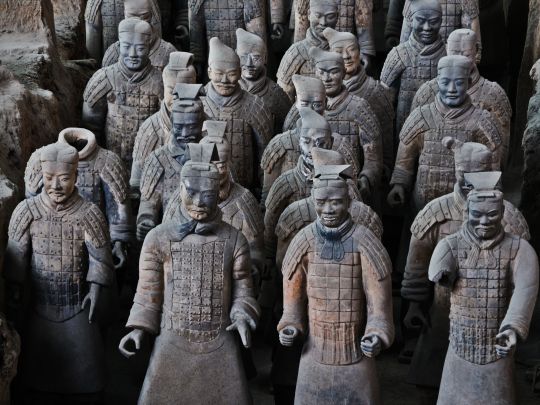
The Terracotta Army is a collection of terracotta sculptures depicting the armies of Qin Shi Huang, the first Emperor of China. It is a form of funerary art buried with the emperor in 210–209 BCE with the purpose of protecting the emperor in his afterlife.
The Terracotta Army was discovered on 29 March 1974 by a group of farmers—Yang Zhifa, his five brothers, and neighbour Wang Puzhi—who were digging a well approximately 1.5 kilometres (0.93 mi) east of the Qin Emperor's tomb mound at Mount Li (Lishan), a region riddled with underground springs and watercourses. For centuries, occasional reports mentioned pieces of terracotta figures and fragments of the Qin necropolis – roofing tiles, bricks and chunks of masonry. This discovery prompted Chinese archaeologists, including Zhao Kangmin, to investigate, revealing the largest pottery figurine group ever found. A museum complex has since been constructed over the area, the largest pit being enclosed by a roofed structure.
The figures vary in height according to their roles, with the tallest being the generals. The figures include warriors, chariots and horses. Estimates from 2007 were that the three pits containing the Terracotta Army held more than 8,000 soldiers, 130 chariots with 520 horses, and 150 cavalry horses, the majority of which remained buried in the pits near Qin Shi Huang's mausoleum. Other terracotta non-military figures were found in other pits, including officials, acrobats, strongmen, and musicians.
Most of the figures originally held real weapons, which would have increased their realism. The majority of these weapons were looted shortly after the creation of the army or have rotted away. Despite this, over 40,000 bronze items of weaponry have been recovered, including swords, daggers, spears, lances, battle-axes, scimitars, shields, crossbows, and crossbow triggers. Most of the recovered items are arrowheads, which are usually found in bundles of 100 units. Studies of these arrowheads suggests that they were produced by self-sufficient, autonomous workshops using a process referred to as cellular production or Toyotism. Some weapons were coated with a 10–15 micrometer layer of chromium dioxide before burial that was believed to have protected them from any form of decay for the last 2200 years. However, research in 2019 indicated that the chromium was merely contamination from nearby lacquer, not a means of protecting the weapons. The slightly alkaline pH and small particle size of the burial soil most likely preserved the weapons.
The swords contain an alloy of copper, tin, and other elements including nickel, magnesium, and cobalt. Some carry inscriptions that date their manufacture to between 245 and 228 BCE, indicating that they were used before burial.
The terracotta army figures were manufactured in workshops by government laborers and local craftsmen using local materials. Heads, arms, legs, and torsos were created separately and then assembled by luting the pieces together. When completed, the terracotta figures were placed in the pits in precise military formation according to rank and duty.
The faces were created using molds, and at least ten face molds may have been used. Clay was then added after assembly to provide individual facial features to make each figure appear different. It is believed that the warriors' legs were made in much the same way that terracotta drainage pipes were manufactured at the time. This would classify the process as assembly line production, with specific parts manufactured and assembled after being fired, as opposed to crafting a figure as one solid piece and subsequently firing it. In those times of tight imperial control, each workshop was required to inscribe its name on items produced to ensure quality control. This has aided modern historians in verifying which workshops were commandeered to make tiles and other mundane items for the terracotta army.
Daily inspiration. Discover more photos at http://justforbooks.tumblr.com
14 notes
·
View notes
Photo

Head from a Tomb Figurine in the Form of a Horse, 1st-3rd century CE, HAM: Sculpture
Harvard Art Museums/Arthur M. Sackler Museum, Gift of Miss Rachel C. Raymond
Size: 18.6 x 18.5 x 5.7 cm (7 5/16 x 7 5/16 x 2 1/4 in.)
Medium: Cold-painted funerary ware: molded gray earthenware with slight traces of cold-painted pigment
https://www.harvardartmuseums.org/collections/object/202507
4 notes
·
View notes
Photo

Horse and rider, early 8th century, China, Tang dynasty (618–907)
Tomb Pottery
Earthenware with three-color (sancai) glaze and pigment
In style and subject matter, this horse and rider with sancai or "three-color" glaze is emblematic of funerary sculpture from the early eighth century, the apex of the Tang dynasty. Free-form splatters and drips of colored glaze were first experimented with in the sixth century and the sancai glazes, made by mixing copper, iron, and cobalt to create a lively spectrum of blues, greens, ambers, and yellows over a milky white background, became fashionable in the early Tang for funerary, utilitarian, and export wares. The distribution of glaze on this horse and rider displays a relative degree of control. The colors clarify, rather than obscure, steed, saddle, boot, tunic, and hood. Swift brushstrokes in black detail the rider's brow and mustache, as well as the saddle blanket and horse's eyes, while etched lines stress the animal's musculature.
The horse itself was a potent image during the vigorous expansion of the Tang "golden age." Chargers such as this large horse were both the reward of military incursions to the west, and the foundation of imperial stability that would in turn encourage trade and prosperity over a vast empire. The most sought-after steeds were known as "blood-sweating horses"; raised in the western kingdom of Ferghana, they were sent in great numbers as tribute to the emperor. Horses also were a sign of wealth: strict sumptuary laws limited the use of the horses to people of a certain rank and even those serving in the military, such as the hooded soldier saluting from astride this horse, had to provide their own mount.
The Metropolitan Museum
6 notes
·
View notes
Text
The Tragic Irony of the U.S. Capitol's Peace Monument
https://sciencespies.com/history/the-tragic-irony-of-the-u-s-capitols-peace-monument/
The Tragic Irony of the U.S. Capitol's Peace Monument

After the storming of Congress in early January, some rioters were apparently surprised to learn that the mere “traffic circle” where they were being arrested was, in fact, the Peace Monument, and part of U.S. Capitol grounds. Mostly unnoticed on ordinary days, the ghostly, eroded statue at the end of Pennsylvania Avenue became a focal point in the news footage of the violent afternoon and remains an enigmatic emblem of its aftermath.
The Peace Monument, strangely enough, got its rocky start as a war memorial, in honor of lost Union sailors and marines. It was conceived by Adm. David Dixon Porter, a famous commander, who intended it for the U.S. Naval Academy in Annapolis, where he served as superintendent. He personally raised funds and, in 1871, commissioned the sculpture, even sketching out his own vision—and taking fire for it. Porter “knows more about the high seas than he does about high art,” one critic sniped.
An amalgam of classical allusions and Victorian funerary motifs, the sculpture remains something of a puzzle to modern eyes. “It’s a mishmash monument,” says Elise Friedland, a George Washington University scholar, who is researching a book about the capital city’s classical art and architecture.
At the top, which reaches around 44 feet, is the bookish muse of History, consulting a tome inscribed “they died that their country might live.” Another female figure, believed to be Grief, cries on History’s shoulder. Below gloats Victory; at her feet are cherubic versions of Mars and Neptune, toying with sword and trident.

Mars and Neptune frolic at Victory’s feet in the elaborate monument designed by a Union admiral.
(Gabriella Demczuk)
And where is the figure of Peace? Tacked onto the back of the sculpture like an afterthought.
Swept away by passion for his memorial project, Porter waited until his final fundraising efforts had all but capsized to share his plans with Secretary of the Navy Gideon Welles. The two men had a contentious relationship—Welles “served his country in its darkest hour with fidelity and zeal, if not with conspicuous ability,” Porter once wrote—and Welles vetoed Porter’s plan. The Naval Memorial, as it was called, would not sail to Annapolis after all, nor be installed at the academy. But Congress scrounged up funds and found a second-best spot, at the foot of Capitol Hill.
Sculpted by the prolific Maine native Franklin Simmons at his studio in Rome, the star-crossed monument was shipped to the District of Columbia in pieces and finished in 1877. The statue of Peace was in fact a last-minute addition, and faces the Capitol in an inexplicably topless state. (“Why is Peace naked?” Friedland wonders.) Peace was perhaps a political compromise, added to mollify former Confederates in Congress who weren’t eager to support a tribute to the Union cause. Porter shot off a note to the Architect of the Capitol: “If this statue don’t make members of Congress feel peaceful I don’t know what will.” A novelty in a city full of war memorials, this makeshift peace shrine was not formally dedicated or even quite finished; the design called for bronze dolphins that still haven’t surfaced.
Made of Carrara marble, a material as vulnerable to the elements as peace itself, the monument has not handled acid rain and pollution well. The human faces have blurred. A marble dove at Peace’s feet flew the coop long ago. Body parts have snapped off and been replaced. Making sense of the elaborate artwork has never been straightforward. “This is the issue with these allegorical monuments,” says University of Pittsburgh art historian Kirk Savage. “They can kind of mean anything.” It’s inevitable, he says, that the monument would “be appropriated for other reasons and uses.” (Besides, he adds, “it seems pretty easy to climb.”) In 1971, Vietnam War protesters scaled the monument and rested with flags at the top, looking like statues themselves. During the insurrection this past January, somebody slung a scarf around Victory’s neck and a guy wearing a cowboy hat and holding a bullhorn loomed over baby Mars, god of war.

The Peace Monument, in a photo taken between 1909 and 1919, once served as a streetcar stop.
(Library of Congress)
Contemporary peace memorials tend toward radical simplicity—an installation outside Oslo City Hall, where the Nobel Peace Prize is handed out, is a smile-shaped arc. But some artists see immense power in antique statuary. Krzysztof Wodiczko, who works with video projections and has beamed the faces of traumatized soldiers onto the Lincoln Memorial in New York City’s Union Square Park, says the Peace Monument’s human forms have a hold on us. “We have a special relationship to those statues. We identify with them. We animate them without knowing who they are. We want them to witness what we want to say. Sometimes we sit on their shoulders and put flags in their hands.”
In the days after the Capitol riot, a new face appeared at the Peace Monument: Brian Sicknick, the Capitol Police officer who died of injuries sustained in the mob attack. Mourners left photographs of him beside cut flowers and American flags. A cardboard sign said, “Rest in Peace.”
British troops torched the building during a chaotic 26 hours in the War of 1812. But the symbol of democracy stood
By Ted Scheinman

Twenty-six months after the United States declared war on Britain, 4,500 British troops under Maj. Gen. Robert Ross serve a humiliating defeat to U.S. forces at Bladensburg, Maryland. Ross orders the redcoats to march the six or more miles to Washington, D.C.
(Courtesy of Stephen Campbell)
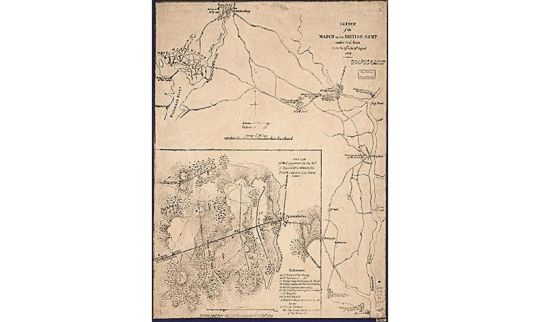
President James Madison, who rode with the American troops at Bladensburg, leaves the field for the capital city but will promptly flee, as will his cabinet. About 90 percent of the population is gone by the time the enemy arrives.
( Library of Congress, Geography and Map Division)

Toward evening, American troops fire on British forces approaching the capital from the northeast, killing several soldiers and Ross’ horse. Still, the invaders prevail before nightfall and are able to raise the Union Jack over Capitol Hill.
(Sarin Images / Granger)
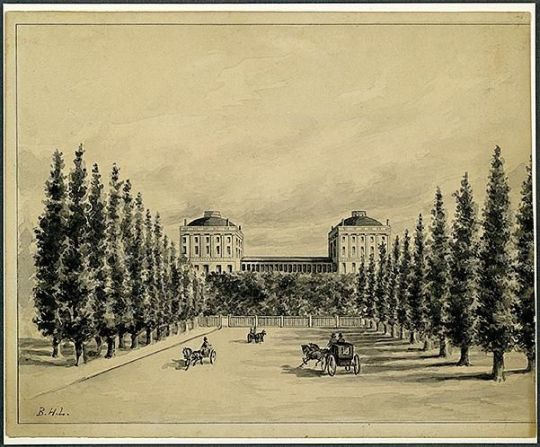
Inside the original Capitol, which was opened to Congress in 1800, British soldiers lay waste to the east side of the South Wing, home to the House of Representatives. The building is largely brick and sandstone, but they slather gunpowder paste on wooden supports and structures and ignite bonfires. The heat is so intense the roof falls in.
(Library of Congress)
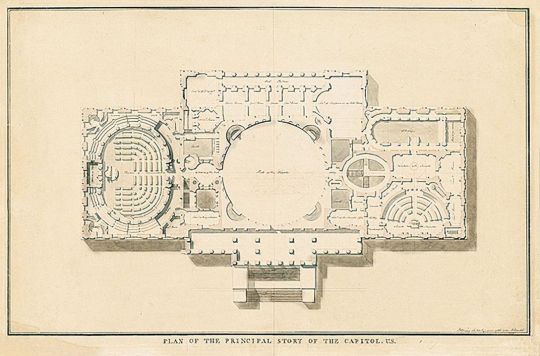
In the North Wing (on the right of the diagram), soldiers burn the Library of Congress (3,000 volumes), torch the Senate chamber and topple marble columns. The heat nearly crumples exterior walls, some of which will be incorporated into a restored and expanded Capitol in coming decades.
(Library of Congress)

British Rear Adm. George Cockburn—who had wanted to burn far more of the city, before Ross declared private property off-limits—infamously stands atop the chair of the House speaker while whipping up his troops. But the occupation doesn’t last: A powerful rainstorm the next day prompts British troops to withdraw from the capital. Four months later, British and American delegates will sign the Treaty of Ghent, putting an official end to the war.
(Library of Congress)
#History
#02-2021 Science News#2021 Science News#Earth Environment#earth science#Environment and Nature#Nature Science#News Science Spies#Our Nature#outrageous acts of science#planetary science#Science#Science Channel#science documentary#Science News#Science Spies#Science Spies News#Space Physics & Nature#Space Science#History
2 notes
·
View notes
Photo
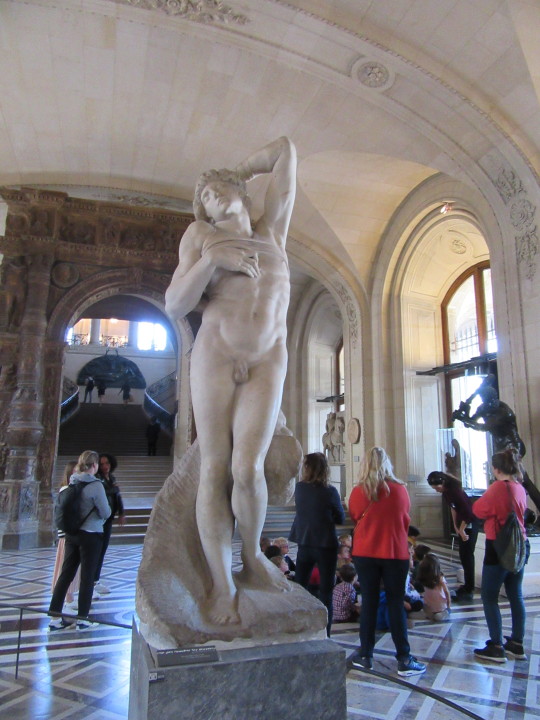

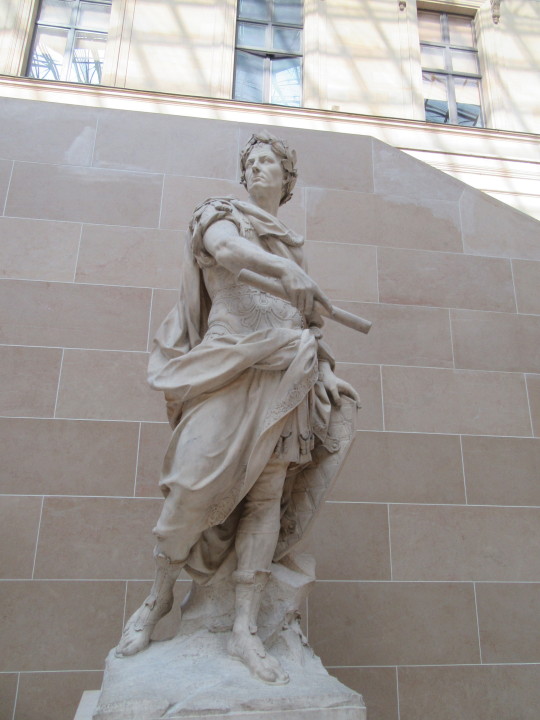
Louvre, Paris, France
Two of these are from the early modern period and the third is Michelangelo, they are linked entirely by not being older than 1500 years.
Photo 1 is Michelangelo’s Dying Slave, which I...almost bypassed entirely, because I was overwhelmed and there were Roman artifacts to find. I do regret this, since there’s a lot of really cool writing out there about the meaning of its unfinished state and the title, whether those are related, which of them have to do with “the Pope changed his mind about his funerary decor”, etc.
Photo 2 is Mercury on Pegasus, sculpted at the end of the 17th century for Louis XIV. For those with an interest in art, the main thing of note here (not the horse) is that it is carved from a single block of marble. There are no joins. There was no room for error. Amazing.
Photo 3 is another round of “I cannot resist things about Julius Caesar”, Nicolas Coustou’s statue. To my regular annoyance, this is one of the main portrayals of him (along with a Renaissance bust, a variety of variously well substantiated ancient busts, paintings, and a bronze that I am 95% sure is actually Octavian). It’s a very sweet sculpture and I love it a lot, but it also...irritates me on an existential level.
10 notes
·
View notes
Photo
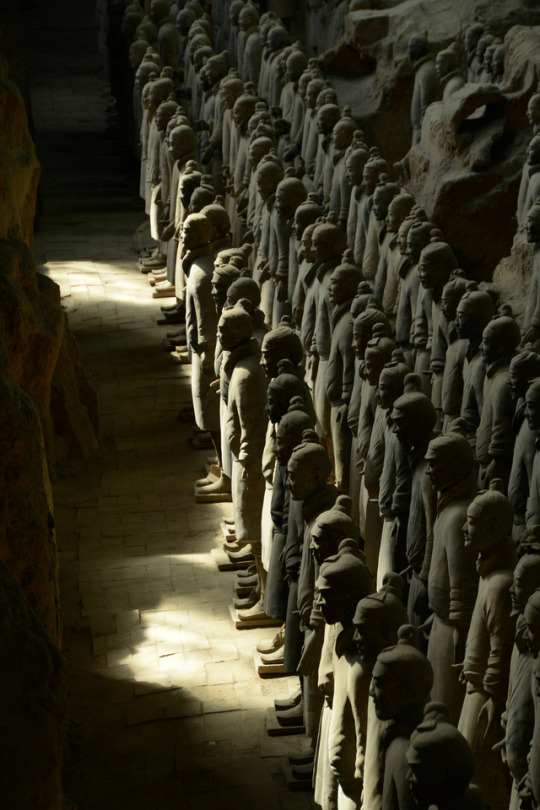
Qin Terracotta Warriors and Horses (Xi’an)
The Terracotta Army is a collection of terracotta sculptures depicting the armies of Qin Shi Huang, the first Emperor of China. It is a form of funerary art buried with the emperor in 210–209 BCE with the purpose of protecting the emperor in his afterlife.
Karen Burgess Photography
#art#sculpture#warriors#army#terracotta#qin#xi'an#china#funerary art#emperor#collectors#antic#antiquity#archeology#qin shi huang#karen burgess
81 notes
·
View notes
Photo
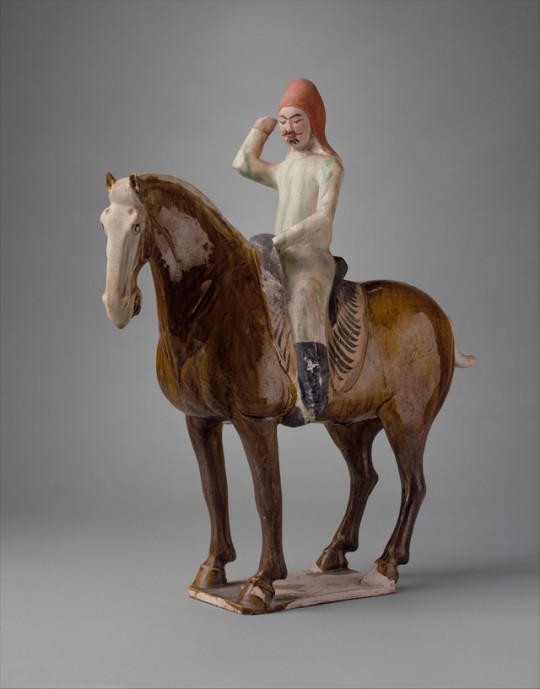
Funerary sculpture with horse and rider
Chinese, Tang Dynasty, early 8th century
earthenware with three-color (sancai) glaze and pigment
Metropolitan Museum of Art
#Chinese art#Asian art#funerary art#funerary sculpture#Tang Dynasty#earthernware#sculpture#statue#Metropolitan Museum of Art#I love Tang funerary sculpture so much#It's probably my favorite type of Chinese art besides Shang bronzes#ceramics
10 notes
·
View notes
Text
FORUM ROMANUM I


THE ARCH OF TITUS
In AD 80, the tenth anniversary of conclusion of the Jewish War, the Senate commissioned a triumphal arch dedicated to the Emperor Titus. Built near the Circus Maximus, the arch carried a dedicatory inscription that cited Titus’ honors and acknowledged his father and co-belligerent, the deified Vespasian. The inscription concludes with a summary description of the nature of Titus’ accomplishment honored by the monument:
Following the advice and example his father, he prevailed over the Judeans and destroyed the city of Jerusalem, which, since time immemorial, had been besieged by generals, kings, and peoples in vain or left unmolested by them.
The inscription therefore cites the emperor’s virtues and provides an example of its manifestation: his good judgment and filial piety are xemplified by his seeking the advice of his senior officer and father, Vespasian, and his skill and determination as a general are proven by the fact that he prevailed where others had failed.

One year later, another arch, also dedicated to Titus, was commissioned by his younger brother, Domitian. Built on a small hill on the Via Sacra, the arch served as a ceremonial gateway to the Forum Romanum. The location of this monument alone indicates that it was designed to serve a very different function than its precursor by the rowdy Circus Maximus. A bronze quadriga adorned the attic, to which a plaque was affixed bearing a dedication prominently carved in straight-line capitals:
Senatus populusque Romanus Divo Tito Divi Vespasiani filio Vespasiano Augusto.
Titus, like Vespasian, is now divine. The arch commemorates his victory over death, in AD 81, through deification. This is expressed in the relief at the center of the coffered soffit of the arch’s passageway, showing Titus carried on the back of an eagle to elysium. Whereas the first arch was triumphal, the second Arch of Titus is a funerary monument. The young emperor’s ashes were deposited in the attic.
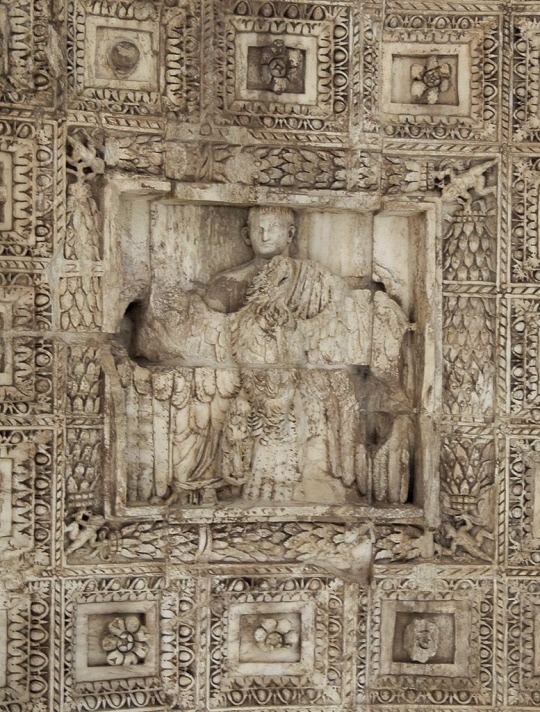
The two Arches of Titus shares more than a dedication. Both monuments cite the pacification of Judea as evidence of Titus’s greatness. Whereas the earlier arch asserts that claim textually in the second part of the inscription, it is expressed on the later arch pictorially. The famous relief sculptures on the walls of the passageway depict Titus in his chariot drawn by 4 white horses and his troops carrying the unmistakable spoils of the temple in Jerusalem.
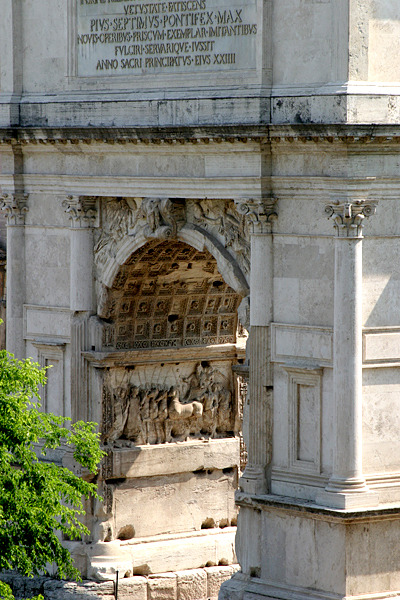
Since the publication of Franz Wickhoff’s Der Wiener Genesis in 1895, the spatial construction and scenographic realism of the panels have been adduced as evidence of the emergence of a distinctly Roman art. If the reliefs are best understood as a continuation of the inscription, as has been persuasively argued*, then inscriptions and epigraphy are essential components of the romanitas of the arch and of Roman imperial art in general.
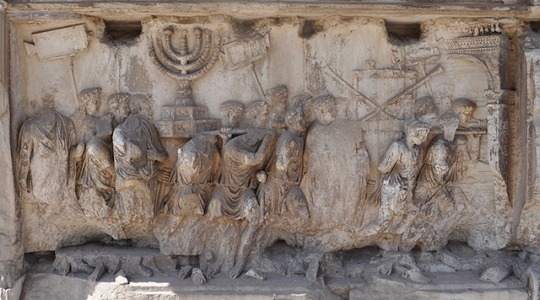
In the Middle Ages, the later arch was incorporated into the walls of the Frangipani family’s fortified residence. What remained of the arch in 18th century can be seen in paintings of the forum. In the 1820s, the arch was completely disassembled, reconstructed, and restored. Much of the marble veneer of the exterior dates from this period; the inscription and stone sculpture are original.
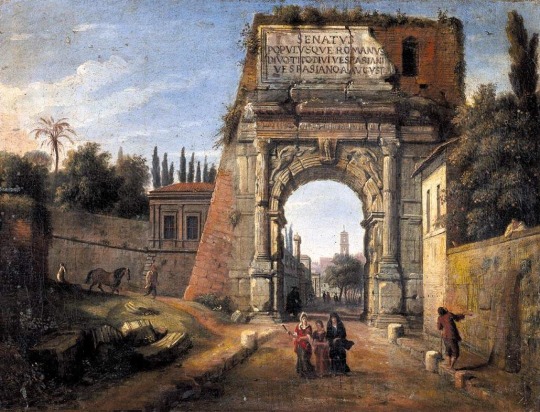
The first arch had been known only through a 9th-century compilation of Roman inscriptions that noted its location near the Circus Maximus. Its precise location was discovered in 2014, when archaeologists excavating at the east end of the Circus Maximus unexpectedly unearthed the column bases and plinths of a massive, three-bay arch. Fragments of sculpture and epigraphy confirmed that this was indeed the triumphal Arch of Titus.
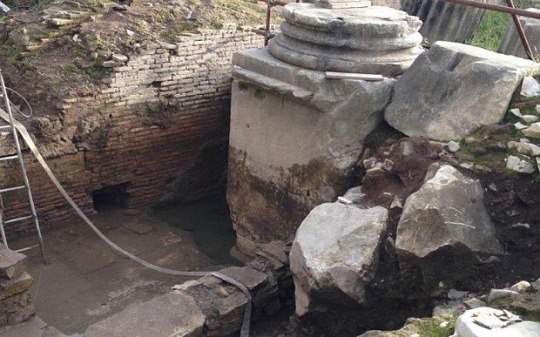
A reconstruction was immediately proposed. However, the area around the Circus Maximus is susceptible to Tiber flooding and the arch’s foundations are below the watertable. To reconstruct the arch at its original location would require the implementation of a drainage system under the monument prior to rebuilding. Until a corporate sponsor is identified, the foundations of the arch have been reburied. A group of smaller fragments can be seen strewn on ground by the site.
* R. Ross Holloway, “Some Remarks on the Arch of Titus,” L’Antiquité classique 56 (1987), 183-191.

17 notes
·
View notes
Text
World Building #1
Note: this is not intended as a how to guide, this is simply my process (so far), but it may help you with your own projects.
Whenever I start a world building project, I always start with a basic map first. There’s no right or wrong way to start, this is just how I do mine. It makes it much easier for me to figure out how everything works together (weather, environment, currents, travel, mountain ranges etc) when I have a basic idea of how the land looks. The following example is my current project and subject to many changes as things evolve.
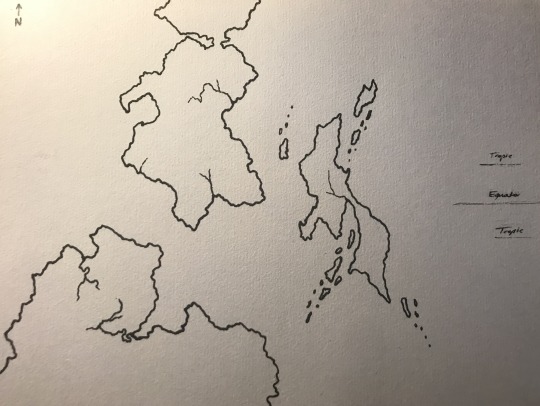
I’m not going to go into how I figure out shapes and all that, it’s not particularly interesting, but importantly (for me), I line in where the equator and tropics would be. From this, we can see where things would logically sit, and I need my world to be logical, let’s blame my years of geographical and geological studies. These areas are the hottest and wettest parts of this world and where you’ll find monsoons and rainforests. Knowing where the rainforests are is a particularly important thing for me with the story involved with this project. I may expand on this in a later post.
Next thing I do is I make lists of things that I would like to figure out about my world. I normally start with the environment, but all I’ve figured out so far is rainforest, and only on the southern continent where the story will be set; that’s all I really need right now. I already have a story idea, and I want to move forward with the people, culture, customs, religion etc. I can figure the rest out later. Without further ado, here is my list of things to consider and build on.
Note: there is a lot of crossover between these sections, I’ve tried to keep to the main subject at hand with the questions asked so it’s not quite as confusing.
Culture
naming conventions (for both people and places) - how do the names work? are children named after their fathers or mothers? other family members? the alignment of the stars? a physical characteristic?
societal structure including hierarchy of class systems and distinctions between them - how different is a poor person from a rich person?
government type and structure - this will have it’s own section further down
housing (architecture, building materials etc) - where and how does this society live? family groups/tribes/cities?
celebrations - which events are celebrated and how (eg births, deaths & marriages)?
festivals and rituals
music, dance & art - what kind of music is listened to? do they dance? what kind of artwork exists in this world/society? are there paintings/sculptures/poetry/songs/musical instruments?
cultural relations - how does this culture think of itself in relation to other cultures? are they better than the next country/town over? are they proud of their achievements or jealous of those of others?
marriage/partnerships - do people get married? is there a ritual involved?
gender roles and sexuality - are there distinctions between genders? will one be shunned from society for not fitting the social norm?
clothing - what do people wear? what is their clothing made of? does it reflect their job or class?
jobs and employment - which jobs are required for this society to function? which are the best and worst jobs?
monetary system/trade - does this society have money? how much is it worth? is it a bartering society? both?
education - are there schools? are there class requirements to attend? how much do they learn? is this a literate society? what is the age range of students?
games, sports and recreation - what do people do for fun? what games do they play? how do children entertain themselves? is there a professional sports league?
food - what food do they eat? are they a predominantly vegetarian society? are they cannibals? do they only eat fish every second weekday? what is the standard fare? are meals eaten in public? with family only?
communal projects - when a house or temple needs to be built, does the community come together? are there monuments? who builds these things? who is in charge of organising them?
military/police force - are there either in this society? is it voluntary? is there a draft? how exactly do they use/abuse their power within this society?
Religion
importance - how important is religion to this society? to what extent does the population share beliefs?
origin story - is there one? how does this society believe the world/universe/god/s came to be?
end of times - what does society believe will happen? is there fire? does the sun explode? a meteor land on a god’s head who then takes his rage out on the planet? does society even care or think about it? will it really happen?
mythology - what are the myths prevalent in this society? do they have any religious beliefs at all?
deity - which god/s does this society worship/believe in?
astrology - do the stars have any power over events in this world? does society believe they do?
afterlife - is there an afterlife? what does this society believe happens when they die? is there a heaven/hell? are there any funerary rites/rituals? do they bury, burn or send their dead off to sea? are there cemeteries?
soul - what does society think the soul is? do they even think about these things? do they believe in soul damage? do their actions affect their souls? are souls reincarnated?
temples/places of worship - how big/important are they? are they any at all? is religion practiced in the privacy of one’s own home? is it compulsory to attend services? are there certain trees which are revered? which gods do they worship? does each deity have their own separate place of worship?
hierarchy - who is running the temples or places of worship? who maintains the properties? how important are priests or their equivalent? who are they in charge of?
festivals - are there any religious festivals practiced in this society? what are the rules? is there a costume or dress-code?
religious texts - is there a bible/koran/book of the dead-type volume? how available is it? does every follower have a copy? do they only know the parts that have been read to them?
prophesies - is there a person who has visions? are they seen as a madman, prophet, or just gifted? do these prophesies come true? are they believed to come true? are they written down, inscribed on temple walls or just passed on through word of mouth?
food - is there any religious influence on what food is forbidden or encouraged? what are the restrictions? when can certain foods be eaten?
magic - is there any magic that is received only from a deity? what kind of magic do deities have? what kind of magic do/can they bestow on their subjects?
Science, Magic & Technology
technology - what kind of technology is available to this society? do they have electricity? is everything steam/wind/water/kinetic powered? does magic make the world go round? are there machines? what are they capable of?
astronomy - does society think their planet is the centre of the universe? what do they know about the stars? do they believe the stars are souls of the dead? the gods looking down on them? do they have telescopes?
calendars/clocks - how is time measured? is it just a block of seasons? do they measure days/weeks/months? do they measure years scientifically through various measures such as astronomy or just at the end of each winter/summer? do they have clocks? sundials? does magic tell them how much time has passed? do the gods?
medicine - what medicine is available? which diseases can be cured and which are incurable? or is it just magic? are doctors/healers trained on the job or in a university-type situation? do they serve an apprenticeship to someone experienced? are there hospitals or medicine women? both?
healthcare (tying back into medicine) - is there a healthcare system? do people pay for healing? are the poor excluded from it? are there doctors/healers who work on a pro bono system? is it free for anyone to receive healthcare?
writing - does this society have a written language? is it hard to learn? how many people are able to read/write? is their written language different from their spoken language? ie English scholars who wrote in Latin.
messages/communication - how are messages transmitted between two people with distance between them? do they write letters? use a mirror? carrier pigeons? is there a postal service? are messages written on paper/slate/stone/leaves? what do they use to write letters with? do they simply send messages via telepathy?
metals - which metals are available? what are these metals used for? how skilled are the metal workers? where is this material mined from? does it just lie on the ground around the place? is it only found in streams on a sunny day? how is this metal transported from it’s resting place to the smithy? who mines it? are there surveyors? do you need to be specially trained to find/work it?
weapons - are weapons commonplace? what kind of weapons are available? how expensive are they? are they only available to the military or the wealthy?
paper - is it available? how common is it? is some other substance used for writing? is it a different colour? is it only available to the wealthy?
glass - is it available? is it common/luxury? is it only available to the wealthy? is it used in windows? are there skilled glaziers? can you see through it? is it full of bubbles?
architecture - what do the buildings look like? do people live in houses/tents/communal spaces? do they have flat/pointed roofs? do they have chimneys? fireplaces? stairs/ladders? are the windows arrow slits? do houses have inside bathrooms? plumbing? how much space is between buildings? how tall are they? do people have separate bedrooms? is one house a series of separate buildings/tents? how is a city/community laid out?
transportation - is there a public transportation system? are there taxis? does everyone have a horse/car/bike/donkey? how are the roads? is it safe to travel alone? is it possible to travel far? are there ships/planes?
Agriculture
produce - what can grow in this world? can it grow all year round? or is it a season-specific plant? is it easy to grow? does it require constant rain? is there a specific fruit/vegetable in high demand?
animals - which animals are farmed on this world? do they provide a variety of resources? ie eggs, meat, leather, fur , labour etc.
fishing - how common is fishing? is it the main source of food? what can be done with fish? what kind of food can be prepared? is this area known for good fishing? are they small/big fish?
farming - how common is farming? is it the main source of food? how big are farms? can a farmer have many different types of produce and animals or just a few? how many farmers are specialised in a specific plant/animal? ie grapes for wine
foraging - what can be foraged? mushrooms/berries/coconuts? does everyone have to forage? how far away from their homes do the have to go to do so?
hunting - is society allowed to hunt the local wildlife or is it prohibited? is it sport for the wealthy? which animals are nearby? do they make good eating? are they only hunted on special occasions? during a specific season?
preservation - which kinds of food can be preserved? are there any highly desired preserved goods? what are the problems that can arise from food preservation?
food stores - which food is able to be stored? can meat be cured? where is food stored? does food need to be stored at all? are there any bugs/beetles/mice that can ruin food stores?
grains - which kinds of grains are available? what can be made from these grains? bread/beer/rice?
irrigation - what kinds of irrigation practices are available? do farmers rely on rainfall/flooding to survive? do they build canals? a sprinkler system?
manufacturing - what kind of products are able to be manufactured from the goods provided from the agriculture industry? do farmers/fisherman/foragers/hunters manufacture their own goods or pass on the raw materials?
trade - does a farmer trade or sell his goods? where do they go to do so? do the buyers come to them? is there a marketplace? how does the farmer transport their goods? horse and cart/train/truck/goat/magic carpet?
Government
government type - democracy, theocracy, monarchy, theocratic monarchy, republic, autocracy etc
succession - how is a new leader chosen? are they voted in? selected from a lottery at random?
hierarchy - who has more power? who is second in command? how equal are the advisors? is the king only a figurehead? are the nobility able to influence government decisions? if society objects to a decision/law made, are they able to petition it effectively?
laws - what are the laws of the land? what is the worst possible crime someone could commit? what can they get away with?
legal system - how does someone refute a claim against them? are there lawyers? is there a courthouse? do they have to petition the king? who makes the final decision? judge/king/priest/god/public?
criminal punishment - what punishments can be expected for those proven guilty of their crimes? prison/death/excommunication/a fine/banishment?
taxes - how much does each person pay in tax? how is this amount decided? who collects the taxes? can the tax be paid in goods? does it have to be paid in goods/money? can someone get an extension/exemption from payment if they don’t have enough?
distribution - how are city funds distributed? are they distributed at all? what percentage of taxes go back into repairing the roads and erecting new town halls/temples?
This is far from a complete list, there are countless things I’ve missed and a hundred questions I haven’t asked, but this is basically how I do it. I find the things that need to be known and then ask questions. And this, my friend, is how I world build.
If there’s interest, I may do a series of posts of my actual answers to these questions, they’ll be much more bite-sized though, I promise.
1 note
·
View note